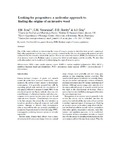| dc.contributor.author | Bond, J.M. | |
| dc.contributor.author | Veenedaal, E.M. | |
| dc.contributor.author | Hornby, D.D. | |
| dc.contributor.author | Gray, A.J. | |
| dc.date.accessioned | 2012-07-11T13:41:48Z | |
| dc.date.available | 2012-07-11T13:41:48Z | |
| dc.date.issued | 2002-11-28 | |
| dc.identifier.citation | Bond, J.M. et al (2002) Looking for progenitors: a molecular approach to finding the origins of an invasive weed, Biological Invasions, Vol 4, No. 4, pp. 349-357 | en_US |
| dc.identifier.issn | 1387-3547 | |
| dc.identifier.uri | http://hdl.handle.net/10311/1025 | |
| dc.description.abstract | One of the major problems in determining the origin of invasive species is that often their arrival is unnoticed. Only when population levels increase is their presence noticed but by this time determining the point of arrival is
confounded by the extensive spread of the species. Here we use molecular markers (ISSRs) to determine the origin
of an invasive weed in the Kalahari region, a species for which several origins could be possible. We show that molecular markers can be useful tools in determining the origin of invasive species. | en_US |
| dc.language.iso | en | en_US |
| dc.publisher | Kluwer Academic Publishers, http://www.springerlink.com | en_US |
| dc.subject | Cenchrus biflorus | en_US |
| dc.subject | Genetic diversity | en_US |
| dc.subject | ISSR | en_US |
| dc.subject | Kalahari | en_US |
| dc.subject | Origin of invasive populations | en_US |
| dc.title | Looking for progenitors: a molecular approach to finding the origins of an invasive weed | en_US |
| dc.type | Published Article | en_US |
| dc.link | http://www.springerlink.com/content/u2h20j080476544x/fulltext.pdf | en_US |

